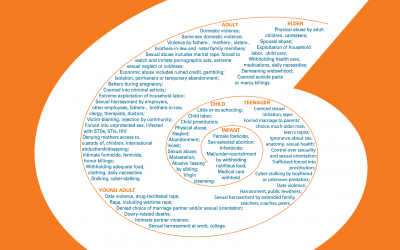Culture impacts the definition of elder mistreatment, help seeking behavior, methods of intervention, and more. It can be a source of both risk and protective factors for an elder. This research brief provides insight into general cultural beliefs, views, norms, etc. of API groups and how they may relate to and influence elder mistreatment. Information is provided on API perception of elder mistreatment, API emphasis of the group/family over the individual, API help seeking behavior assessment of elder mistreatment, considerations for intervention, and on cultural considerations for elder mistreatment by API sub-group.
Related Resources
Lifetime Spiral of Gender Violence
The Lifetime Spiral reveals patterns of victimization by enumerating the types of violence, vulnerabilities, and harms women and girls face.
Elder Abuse in Asian Families: Contexts and Dynamics, 2015
These training slides enumerate several types of abuses faced by API elders while offering recommendations for advocates.
Survivors in the Margins: The Invisibility of Violence Against Older Women, 2015
Crockett C, Brandl B, & Dabby C. 2015. Journal of Elder Abuse & Neglect. 27(4-5): 291-302.
This article explores how the lack of gender analysis in the elder abuse field increases older survivors’ invisibility and calls for applying a lifespan approach to abuse.
Aging With Respect: An Elder Abuse Early Intervention and Prevention Safety Card
By Futures Without Violence & National Clearinghouse on Abuse in Later Life
Aging with Respect is an intervention addressing elder abuse, neglect and intimate partner violence with those later in life utilizing the Aging with Respect safety card. It is developed for those patients/clients with agency and capacity in non-crisis, non-emergency situations that provides information about healthy and safe relationships, and the impact of unhealthy relationships on health and wellbeing. Topics include financial, emotional, and physical abuse and exploitation, education and prevention strategies, and information on seeking support.
By the National Center on Elder Abuse (NCEA)
2013
Additional factsheets on elder abuse are available here from ncea.org



